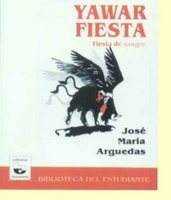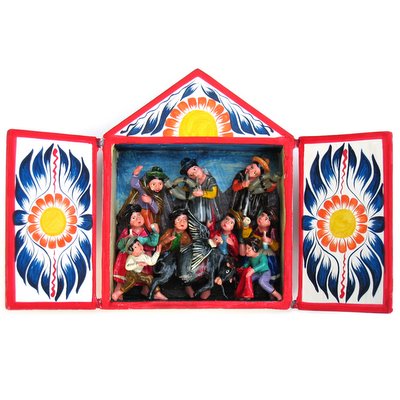
That's what they had wanted! To shock Puquio. To take charge [ser mando], if only for one day, of the whole town. (133)Arguedas's Yawar fiesta dramatizes a complex series of power struggles. What's at stake is also the format and interpretation of those struggles.
The focus is a festival in the Andean town of Puquio, a festival celebrated on Peru's national day (July 28th), but whose roots reach back to the founding trauma of Spanish colonization.
Traditionally, the centerpiece has been a rough and ready bullfight, in which representatives of the various ayllus that constitute the town's indigenous majority compete for the honour of their clan by braving the fiercest wild bulls brought down from the remote upland puna. This contest can be a brutal and bloody affair, in which young men fortified by copious quantities of drink hurl themselves at the untamed animals, often coming off worst in the encounter. Indeed, much of the anticipation and excitement surrounding this "Festival of Blood" is provoked by the evident danger and the likelihood of serious injury or death.
This year, however, things will be different. An order has come down from the government that bans such amateur displays. The subprefect assigned to the town is determined to ensure that a "civilized" display will replace customary "savagery." He enlists the local notables in his cause, who in turn call upon townsfolk who have emigrated to Lima. These émigrés, driven by their experience with urban modernity but also new intellectual fashions, are all too keen to return to their hometown in the service of this civilizing mission. They hire a professional bullfighter, a Spaniard eking out the twilight of his career, and bring him to the Andes determined to teach a lesson as much to the provincial oligarchy as to the "backward" Indians.
So just as the ayllus compete among themselves for prestige, as well as to show the mistis what indigenous organization, bravery, and force of will can achieve, so also the local landowners and merchants are split: some more favourable to the modernizing influence brought by the state and even by a radicalism inspired by the Marxist José Carlos Mariátegui; others, including the largest and most feared landowner of all, strangely allied with the Indians they admit to oppressing in their desire that this semi-Rabelasian carnival should go ahead.
Nothing is simple in Arguedas's delicately poised account. It is the indigenous, for instance, who have themselves opened Puquio up to modernization by building, of their own accord and with impressive industriousness, the highway that links the highland town to the coast. We are led to feel a certain sympathy for the gamonal Don Julián as well as for the shopkeeper Don Pancho, both of whom profit from exploitation, but who are incarcerated by the subprefect for daring to champion tradition against the state's purported rationalization.
Even the Lima-based mestizos are treated with much subtlety and ambivalence: they are at least prepared to recognize and name the oppression endemic to these semi-feudal relations, even if their educative desires are portrayed as ill-judged and arrogant: "We'd need a thousand years to save the Indians from their superstitions," says one (128). "That depends," another replies.
If we were the Government, my brothers! What would happen? We would do away with the causes that have allowed primitivism and servitude to survive for so many centuries. (129)These men, whose most vocal member is the "student" Escobar, aspire to be the organic intellectuals of a liberated peasantry. They show their willing affiliation with the indigenous by literally putting their shoulders to the effort of bringing the bull Misitu into town at the same time as they try to frustrate the very purpose of that effort, by also importing the professional matador to substitute for Misitu's indigenous challengers.
In the end, the carnivalesque trumps this attempted imposition of a hegemonic relation. The Spaniard serves up a particularly unedifying spectacle, running for cover almost as soon as Misitu is let loose in the ring. The mistis themselves, led by Puquio's mayor, reject the subprefect and the émigrés' authority alike, calling on the indigenous challengers to enter the scene. And blood is indeed spilled. The novel ends with the mayor's assertion of nativism, of pride in the locality and in the prowess but also the sacrifice of its indigenous multitude:
Do you see, Mr Subprefect? These are our bullfights. The true yawar punchay! (156; emphasis added)And the possessive "our" is an assertion of ownership, but also the recognition of a complex totality in which the dominant are finally dependent upon the subaltern's constituent power.

No comments:
Post a Comment